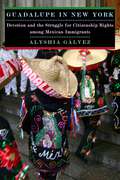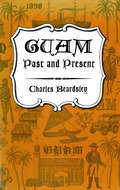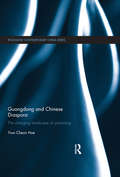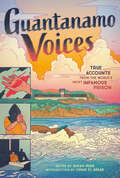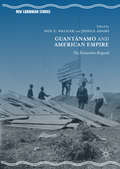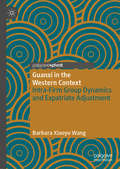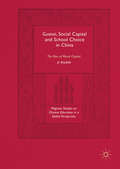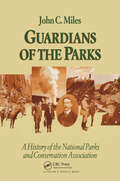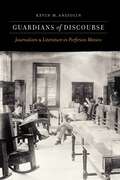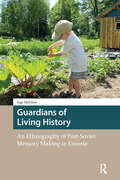- Table View
- List View
Guadalupe in New York: Devotion and the Struggle for Citizenship Rights among Mexican Immigrants
by Alyshia GalvezEvery December 12th, thousands of Mexican immigrants gather for the mass at New York City’s St. Patrick’s Cathedral in honor of Our Lady of Guadalupe’s feast day. They kiss images of the Virgin, wait for a bishop’s blessing—and they also carry signs asking for immigration reform, much like political protestors. It is this juxtaposition of religion and politics that Alyshia Gálvez investigates in Guadalupe in New York.The Virgin of Guadalupe is a profound symbol for Mexican and Mexican-American Catholics and the patron saint of their country. Her name has been invoked in war and in peace, and her image has been painted on walls, printed on T-shirts, and worshipped at countless shrines. For undocumented Mexicans in New York, Guadalupe continues to be a powerful presence as they struggle to gain citizenship in a new country.Through rich ethnographic research that illuminates Catholicism as practiced by Mexicans in New York, Gálvez shows that it is through Guadalupan devotion that many undocumented immigrants are finding the will and vocabulary to demand rights, immigration reform, and respect. She also reveals how such devotion supports and emboldens immigrants in their struggle to provide for their families and create their lives in the city with dignity.
Guam Past and Present
by Charles BeardsleyThis expansive history of Guam provides a rare look at the people and culture of this tiny, but strategically important Pacific Island.In a highly readable style author Beardsley-himself a sometime resident of Guam-introduces the reader to the island in three stages. Part One, "The Island in Profile," furnishes practical information on the geography, flora, fauna, aboriginal inhabitants, early culture, and legends of Guam.Part Two, "Discovery and Conquest," traces its history from the days of European exploration, beginning with Magellan's discovery of the island in 1521 and continuing down through the Spanish colonial period to the arrival of the Americans in 1898 following Spain's cession of Guam to the United States.Part Three, "Twentieth-Century Guam," is concerned with the island under U.S. administration and, during World War II, Japanese occupation; its recapture in 1944; its reconstruction and progress toward true territorial status; and its present-day position as a vital American outpost in the Western Pacific.Important and informative for resident and visitor alike, this enjoyable and attractively illustrated introduction to Guam also holds interest for the general reader who is susceptible to the lure of colorful events against equally colorful backgrounds.
Guangdong and Chinese Diaspora: The Changing Landscape of Qiaoxiang (Routledge Contemporary China Series)
by Yow Cheun HoeChina’s rapid economic growth has drawn attention to the Chinese diasporic communities and the multiple networks that link Chinese individuals and organizations throughout the world. Ethnic Chinese have done very well economically, and the role of the Chinese Diaspora in China’s economic success has created a myth that their relations with China is natural and primordial, and that regardless of their base outside China and generation of migration, the Chinese Diaspora are inclined to participate enthusiastically in China’s social and economic agendas. This book seeks to dispel such a myth. By focusing on Guangdong, the largest ancestral and native homeland, it argues that not all Chinese diasporic communities are the same in terms of mentality and orientation, and that their connections to the ancestral homeland vary from one community to another. Taking the two Cantonese-speaking localities of Panyu and Xinyi, Yow Cheun Hoe examines the hierarchy of power and politics of these two localities in terms of their diasporic kinsfolk in Singapore and Malaysia, in comparison with their counterparts in North America and Hong Kong. The book reveals that, particularly in China’s reform era since 1978, the arguably primordial sentiment and kinship are less than crucial in determining the content and magnitude of linkages between China and the overseas Chinese. Rather, it suggests that since 1978 business calculation and economic rationale are some of the key motivating factors in determining the destination and degree of diasporic engagement. Examining various forms of Chinese diasporic engagement with China, this book will appeal to students and scholars of Chinese Diaspora, Chinese culture and society, Southeast Asian culture and society and ethnicity.
Guantanamo Voices: True Accounts from the World's Most Infamous Prison
by Sarah MirkAn anthology of illustrated narratives about the prison and the lives it changed forever. In January 2002, the United States sent a group of Muslim men they suspected of terrorism to a prison in Guantánamo Bay. They were the first of roughly 780 prisoners who would be held there—and forty inmates still remain. Eighteen years later, very few of them have been ever charged with a crime.In Guantánamo Voices, journalist Sarah Mirk and her team of diverse, talented graphic novel artists tell the stories of ten people whose lives have been shaped and affected by the prison, including former prisoners, lawyers, social workers, and service members. This collection of illustrated interviews explores the history of Guantánamo and the world post-9/11, presenting this complicated partisan issue through a new lens.“These stories are shocking, essential, haunting, thought-provoking. This book should be required reading for all earthlings.” —The Iowa Review“This anthology disturbs and illuminates in equal measure.” —Publishers Weekly“Editor Mirk presents an extraordinary chronicle of the notorious prison, featuring first-person accounts by prisoners, guards, and other constituents that demonstrate the facility’s cruel reputation. . . . An eye-opening, damning indictment of one of America’s worst trespasses that continues to this day.” —Kirkus Reviews
Guantánamo and American Empire: The Humanities Respond (New Caribbean Studies)
by Jessica Adams Don E. WalicekThis book explores the humanities as an insightful platform for understanding and responding to the military prison at Guantánamo Bay, other manifestations of “Guantánamo,” and the contested place of freedom in American Empire. It presents the work of scholars and writers based in Cuba’s Guantánamo Province and various parts of the US. Its essays, short stories, poetry, and other texts engage the far-reaching meaning and significance of Gitmo by bringing together what happens on the U.S. side of the fence—or “la cerca,” as it is called in Cuba—with perspectives from the outside world. Chapters include critiques of artistic renderings of the Guantánamo region; historical narratives contemplating the significance of freedom; analyses of the ways the base and region inform the Cuban imaginary; and fiction and poetry published for the first time in English. Not simply a critique of imperialism, this volume presents politically engaged commentary that suggests a way forward for a site of global contact and conflict.
Guanxi in the Western Context: Intra-Firm Group Dynamics and Expatriate Adjustment
by Barbara Xiaoyu WangDeeply rooted in Chinese culture, the concept of guanxi has been widely researched from historical, cultural and political perspectives. As Chinese multinational corporations (MNCs) expand, expatriates are increasingly carrying guanxi with them to host countries, yet little has been written on how this indigenous construct is employed in the Western world. This book takes a theoretical approach to the examination of this phenomenon and proposes a conceptual framework for the ‘guanxi capitalism structure,’ illustrating its fundamental role as the invisible hand in China. Providing empirical analysis, the author demonstrates how guanxi affects intra-firm multicultural group dynamics involving Chinese expatriates and host-country natives in Chinese MNCs. With insights for scholars researching Asian business and globalisation, and practitioners working in Chinese MNCs, this book argues that guanxi significantly alters an expatriate’s adjustment, and offers practical suggestions for cross-cultural management and the process of initiating, building, and utilising guanxi in a Western context.
Guanxi, Social Capital and School Choice in China: The Rise of Ritual Capital (Palgrave Studies on Chinese Education in a Global Perspective)
by Ji RuanThis book focuses on the use of guanxi (Chinese personal connections) in everyday urban life: in particular, how and why people develop different types of social capital in their guanxi networks and the role of guanxi in school choice. Guanxi takes on a special significance in Chinese societies, and is widely-discussed and intensely-studied phenomenon today. In recent years in China, the phenomenon of parents using guanxi to acquire school places for their children has been frequently reported by the media, against the background of the Chinese Communist Party’s crackdown on corruption. From a sociological perspective, this book reveals how and why parents manage to do so. Ritual capital refers to an individual's ability to use ritual to benefit and gain resources from guanxi.
Guardianas
by Emilia DiazGuardianas es un libro que no termina cuando finaliza su lectura. Invita a recuperar el poder sanador de los encuentros. Guardianas habla de mujeres sabias que mantienen el fuego encendido siempre. Las Guardianas son mujeres comunes con historias excepcionales. También son mujeres excepcionales con historias comunes. Inquietas, curiosas, sabias y vehementes. Con credos variados y sin ellos, atesoran un saber en torno al bienestar social y natural. Son portadoras de un don, aunque algunas lo nieguen. Con algunas debimos hacer de tripa corazón para obtener una foto. Con otras tuvimos que hablar de muchas otras cosas antes que de ellas mismas. En muchas oportunidades no supimos cuándo empezó nuestro encuentro ni cuándo terminó. Muchas, la mayoría, nos generaron un efecto hipnótico que hizo que perdiéramos la noción del tiempo y el espacio. Este libro persigue un fin: dar voz a guardianas de saberes heredados, soñados, intuidos, estudiados, producidos y compartidos en Uruguay. Saberes que no necesitan togas ni aplausos; que se multiplican anclados a un territorio, a la naturaleza y a su gente. Guardianas es un grito, un llamado a despertar el valor de lo comunitario y la memoria de nuestras raíces. En un mundo que hoy pretende normalizar distanciamientos, las Guardianas nos invitan a recuperar el poder sanador de los encuentros.
Guardians Of The Parks: A History Of The National Parks And Conservation Association
by John C. MilesFirst published in 1995. This volume traces the origin and development of America's national park citizen 'watchdog' organisation. Giving an insider's perspective, and reflecting an outsiders quest for objectivity, it will be of interest to every park enthusiast and conversation historian.
Guardians of Discourse: Journalism and Literature in Porfirian Mexico
by Kevin M. AnzzolinDuring Porfirio Díaz&’s thirty-year rule, Mexico dealt with the press in disparate ways in hopes of forging an informed and, above all, orderly citizenry. Even as innumerable journalists were sent to prison on exaggerated and unfair charges of defamation or slander, Díaz&’s government subsidized multiple newspapers to expand literacy and to aggrandize the image of the regime. In Guardians of Discourse Kevin M. Anzzolin analyzes the role and representation of journalism in literary texts from Porfirian Mexico to argue that these writings created a literate, objective, refined, and informed public. By exploring works by Porfirian writers such as Emilio Rabasa, Ángel del Campo, Rafael Delgado, Laura Méndez de Cuenca, and Salvador Quevedo y Zubieta, Anzzolin demonstrates that a primary goal of the lettered class was to define and shape the character of public life, establish the social position of citizens, and interrogate the character of civil institutions. These elite letrados—whom Anzzolin refers to as &“guardians of discourse&”—aimed to define the type of discourses that would buttress the transformed Mexico of the Díaz regime to forge a truly national literature that could be discussed among an expanded coterie of lettered thinkers. In addition, these Porfirian guardians hoped to construct an extensive and active public able to debate political and social issues via a press befitting a modern nation-state and create a press that would be independent, illuminating, and distinguished. Through an innovative look at Mexico&’s public sphere via literary fiction in the Porfirian era, Anzzolin contributes to our knowledge of Mexican and Latin American political, cultural, and literary history in the late nineteenth and early twentieth centuries.
Guardians of Living History: An Ethnography of Post-Soviet Memory Making in Estonia (Heritage and Memory Studies)
by Inge MelchiorGuardians of Living History: An Ethnography of Post-Soviet Memory Making in Estonia interrogates how people living in a society with an extremely complicated, violent past, only a short history of independence, and a desire to belong to Europe engage with the past, both within their families and as members of a national community. In line with other scholarship on memory, this book shows that many Estonians desire an established collective story, as they live in a society where their national identity is quite regularly under threat. At the same time however, that same closure is perceived to pose a threat to the survival of Estonian culture and independence. Guardians of Living History provides an intimate insight into the lives of Estonians from the countryside, former deportees, young intellectuals, and memory activists, who all in their own ways act as guardians of a national history: a history which they wish to keep alive, apolitical, and as close to their family stories as possible.
Guardians of Necessity: The Ultimate Human Right and Obligation
by Scott Hathway BarlowYou are alone and finishing up some shopping at the local mall when you hear a young woman scream for help. You notice that she’s surrounded by several men. Your mind begins the justification process: she is just playing; someone else will come to her aid. As you hesitate, the young woman is dragged into a van and they disappear. Already late for a meeting, as you power walk toward your office you see a young boy crying and being dragged to a car. Your mind begins the justification process: the child is just being petulant; if it is really an issue, others will jump in to help the child. You hesitate and the boy is forced into the car, and they disappear. You just arrive home from work exhausted and ready for supper. You see your elderly next-door neighbor, who lives alone, being verbally belittled by a worker he hired to do some type of chore. Your mind begins the justification process: it’s a dispute between them; I don’t know my neighbor well enough to intervene. In each of these cases, would you be surprised to learn that the young woman was abducted and murdered, the young boy is still missing, and the elderly neighbor was just scammed of a significant portion of his life savings? Most of us think we are not capable of rendering aid. If we do, we reason, we could be hurt, sued, or embarrassed because we misinterpreted the situation. Guardians of Necessity recognizes the right of all humans to defend themselves and others against an attack. This right is in reality an obligation that carries an awesome responsibility. Within these pages the reader is taken through the history of this right, the legal and political climate surrounding this right, and the importance of preparing to exercise this ultimate right.
Guardians of the Community: The Block Parent® Program of Canada
by Kim Varma Kanwal KhokharThe Block Parent® Program of Canada was launched in 1968 following a tragic child abduction and homicide in Ontario. It rapidly expanded across the country, becoming the largest volunteer-led child safety initiative. For over fifty years, the program relied on volunteer homemakers, mostly stay-at-home mothers, who signaled their homes as safe havens for distressed children. Supported by partnerships with police, local businesses, and schools, the program provided a community-based approach to child protection. Although participation declined over the years, recent concerns about bullying, traffic safety, and child protection have sparked renewed interest in Block Parent communities. Guardians of the Community examines the social, political, technological, and cultural conditions that shifted along with the program to understand the landscape of child protection and community crime prevention over the last five decades. The book draws upon open-ended interviews with key figures who were instrumental in launching and leading the Block Parent Program, analyses of annual reports and documents from the program, and public sources including newspapers, social media, and Hansard debates to explore public and political perceptions of the program and related safety concerns. In exploring the motivations underlying involvement in child safety programs, Guardians of the Community reveals the connections between community engagement and cohesion, civic responsibility, and concerns around child protection.
Guarding Against Crime: Measuring Guardianship within Routine Activity Theory (Environment, Space And Criminology Ser.)
by Danielle M. ReynaldThis ground-breaking book examines the critical role that citizens play in guarding against crime. By focusing on the ways in which residents are able to capably guard their residential environments from crime, Reynald shows how local residents function (or fail to function) as effective crime controllers. The studies contained herein are aimed at developing our theoretical, empirical and practical understanding of the function of the capable guardian as a critical, yet elusive actor in the crime event model. In lieu of utilizing secondary data sources for proxy measures, this book argues in favour of new, more direct measures of guardianship, employing direct methods of primary data collection in order to capture the action dimensions of capable guardianship, as well as various other environmental and contextual factors that affect it. It features observations of guardianship in action and interviews with guardians to elucidate the factors that empower guardians to make them capable of crime control.
Guarding the Golden Door: American Immigration Policy and Immigrants since 1882
by Roger DanielsAs renowned historian Roger Daniels shows in this brilliant new work, America's inconsistent, often illogical, and always cumbersome immigration policy has profoundly affected our recent past. <P><P>The federal government's efforts to pick and choose among the multitude of immigrants seeking to enter the United States began with the Chinese Exclusion Act of 1882. Conceived in ignorance and falsely presented to the public, it had undreamt of consequences, and this pattern has been rarely deviated from since. <P><P>Immigration policy in Daniels' skilled hands shows Americans at their best and worst, from the nativist violence that forced Theodore Roosevelt's 1907 "gentlemen's agreement" with Japan to the generous refugee policies adopted after World War Two and throughout the Cold War. And in a conclusion drawn from today's headlines, Daniels makes clear how far ignorance, partisan politics, and unintended consequences have overtaken immigration policy during the current administration's War on Terror. <P><P>Irreverent, deeply informed, and authoritative, Guarding the Golden Door presents an unforgettable interpretation of modern American history.
Guarding the Golden Door: American Immigration Policy and Immigrants since 1882
by Roger Daniels“Immigration is now front-page news, and to grasp the background of current issues this is the book to read.” —David Reimers, author of Unwanted Strangers: American Identity and the Turn Against ImmigrationAs renowned historian Roger Daniels shows in this brilliant new work, America’s inconsistent, often illogical, and always cumbersome immigration policy has profoundly affected our recent past.The federal government’s efforts to pick and choose among the multitude of immigrants seeking to enter the United States began with the Chinese Exclusion Act of 1882. Conceived in ignorance and falsely presented to the public, it had undreamt of consequences, and this pattern has been rarely deviated from since.Immigration policy in Daniels’ skilled hands shows Americans at their best and worst, from the nativist violence that forced Theodore Roosevelt’s 1907 “gentlemen’s agreement” with Japan to the generous refugee policies adopted after World War Two and throughout the Cold War. And in a conclusion drawn from today’s headlines, Daniels makes clear how far ignorance, partisan politics, and unintended consequences have overtaken immigration policy.Irreverent, deeply informed, and authoritative, Guarding the Golden Door presents an unforgettable interpretation of modern American history.“Engaging and lively.” —Publishers Weekly“As Americans continue to debate immigration in a world divided by international terrorism, few books offer a fuller context for the key issues.” —Booklist“A powerful and provocative argument about why the United States has remained an immigrant country—and why it should stay one for its own benefit.” —Eric Rauchway, author of Murdering McKinley
Guatemala. El silencio del gallo: Un misionero español en la guerra más cruenta de América
by Carlos SantosUn impresionante testimonio de coraje y determinación frente a las atrocidades cometidas en Guatemala contra los últimos mayas. En la década de los sesenta, Luis Gurriarán, un joven misionero recién salido del seminario, llega a Guatemala con la tarea de evangelizar a un poblado de indígenas mayas. El caciquismo, la impresionante miseria y la explotación brutal de estos nativos removerán su fe, que empezará a transitar por la senda de un cristianismo utópico, social. En plena guerra fría, con el eje occidental empeñado en perseguir la subversión en América Latina, la labor evangelizadora de estos misioneros estuvo a menudo en el punto de mira. Pese a los problemas y tensiones, la alianza -no muy frecuente- de la Iglesia con los pobres dio como fruto una lenta transformación hacia el progreso de las comunidades en que se asentaron. Entre el periodismo de investigación y la narración histórica, este libro rompe el silencio existente sobre la guerra más cruenta y menos conocida de América, al tiempo que permite entender tanto la Teología de la Liberación como los movimientos guerrilleros centroamericanos del siglo XX. El testimonio de este misionero español, que denunció ante la ONU, junto con Rigoberta Menchú, al gobierno guatemalteco de Ríos Montt en 1982, repasa cuarenta años de historia a partir de cartas, fotografías, grabaciones, documentos y decenas de conversaciones con su sobrino y autor del trabajo, Carlos Santos.
Guatemalan Journey
by Stephen Connely BenzGuatemala draws some half million tourists each year, whose brief visits to the ruins of ancient Maya cities and contemporary highland Maya villages may give them only a partial and folkloric understanding of Guatemalan society. In this vividly written travel narrative, Stephen Connely Benz explores the Guatemala that casual travelers miss, using his encounters with ordinary Guatemalans at the mall, on the streets, at soccer games, and even at the funeral of massacre victims to illuminate the social reality of Guatemala today. The book opens with an extended section on the capital, Guatemala City, and then moves out to the more remote parts of the country where the Guatemalan Indians predominate. Benz offers us a series of intelligent and sometimes humorous perspectives on Guatemala's political history and the role of the military, the country's environmental degradation, the influence of foreign missionaries, and especially the impact of the United States on Guatemala, from governmental programs to fast food franchises. Guatemala draws some half million tourists each year, whose brief visits to the ruins of ancient Maya cities and contemporary highland Maya villages may give them only a partial and folkloric understanding of Guatemalan society. In this vividly written travel narrative, Stephen Connely Benz explores the Guatemala that casual travelers miss, using his encounters with ordinary Guatemalans at the mall, on the streets, at soccer games, and even at the funeral of massacre victims to illuminate the social reality of Guatemala today. The book opens with an extended section on the capital, Guatemala City, and then moves out to the more remote parts of the country where the Guatemalan Indians predominate. Benz offers us a series of intelligent and sometimes humorous perspectives on Guatemala's political history and the role of the military, the country's environmental degradation, the influence of foreign missionaries, and especially the impact of the United States on Guatemala, from governmental programs to fast food franchises.
Guatemalan Vigilantism and the Global: A Tale of Two Lynchings (Routledge Studies in Anthropology)
by Gavin WestonThis book grounds an understanding of lynching as an increasingly globalised phenomenon through an examination of two cases in Guatemala. The chapters cover issues of migration, tourism, gangs, inter-generational conflict, media, gossip, and rumour to understand national and global patterns of mob-based vigilantism and how diverse factors are funnelled into singular acts of violence. Gavin Weston critically engages with the discussion of Guatemalan lynchings as a form of post-conflict violence alongside other less direct chains of causation. Lynchings have complex, tiered causations based in contestations regarding ideas and provision of justice. Underlying social problems and similarities in the way lynchings spread through talk and media make them relatively anticipatable in certain contexts and suggest possible spaces for mitigation against their viral spread. This volume will be relevant to Latin Americanists and those interested in the anthropology and sociology of violence, post-conflict violence, and peace studies.
Guatemaltecas: The Women's Movement, 1986-2003
by Susan A. BergerAfter thirty years of military rule and state-sponsored violence, Guatemala reinstated civilian control and began rebuilding democratic institutions in 1986. Responding to these changes, Guatemalan women began organizing to gain an active role in the national body politic and restructure traditional relations of power and gender. <P><P>This pioneering study examines the formation and evolution of the Guatemalan women's movement and assesses how it has been affected by, and has in turn affected, the forces of democratization and globalization that have transformed much of the developing world.<P>Susan Berger pursues three hypotheses in her study of the women's movement. She argues that neoliberal democratization has led to the institutionalization of the women's movement and has encouraged it to turn from protest politics to policy work and to helping the state impose its neoliberal agenda. She also asserts that, while the influences of dominant global discourses are apparent, local definitions of femininity, sexuality, and gender equity and rights have been critical to shaping the form, content, and objectives of the women's movement in Guatemala. And she identifies a counter-discourse to globalization that is slowly emerging within the movement. Berger's findings vigorously reveal the manifold complexities that have attended the development of the Guatemalan women's movement.
Guerracruz: Rinconcito donde hacen su nido las hordas del mal
by Violeta SantiagoVeracurz: tierra de fosas clandestinas y corrupción política, de homicidios a periodistas y lucha sangrienta de cárteles. Lo que fue un estado de esplendor cultural hoy es espejo de México donde se refleja el infierno de la impunidad y el delito. Desde hace varios lustros Veracruz dejó de ser una tierra festiva para convertirse en un estado del país con los males sociales más demoledores: huachicoleo, secuestro, narcofosas, levantones capiteneados por policías y sicarios, complicidad de políticos y asesinos, desapariciones forzadas... en estas páginas se ofrece un recuento de los daños que es, al mismo tiempo, una denuncia, un relato de la pesadilla política y social que hoy padece Veracruz... y todo México. Guerracruz es una investigación implacable que exhibe la indolencia de gobernadores, agentes ministeriales, presidentes municipales y policías ante las madres rastreadoras en busca de sus hijos, las denuncias por desaparición de estudiantes, obreras, trabajadores o activistas. Violeta Santiago devela el legado macabro de los Javier Duarte de Ochoa y los Miguel Ángel Yunes Linares con sus políticos cínicos, siniestros; el asesinato impune a cientos de víctimas, incluso niños y el pesar de los ciudadanos ante la ola creciente de asaltos violentos y extorsiones. Entrevistas a numerosas víctimas, crónicas escritas con la angustia por no saber si serás el siguiente corresponsal asesinado, análisis político y datos duros conforman este libro esencial para entender el presente de México; un reclamo audaz para señalar que, a pesar del abandono ciudadano por parte de gobiernos y autoridades, hay colectivos fervientes, activistas y periodistas cuya respuesta ante la injusticia es la solidaridad, alzar la voz y dar nombre a los desaparecidos, a los muertos del -quizá- cementerio clandestino más grande del mundo que hoy también es Veracruz.
Guerrilla Aesthetics: Art, Memory, and the West German Urban Guerrilla
by Kimberly MairThe violent operations performed in the 1970s by West German urban guerrillas – such as the Red Army Faction (RAF) – were so vivid and incomprehensible that it seemed to be more urgent to produce spectacle than to be politically successful. In Guerrilla Aesthetics, Kimberly Mair challenges the assumption that these guerrillas sought to realize specific political goals. Instead, she tracks the guerrilla fighters’ plunge into an avant-garde-inspired negativity that rejected rationality and provoked the state. Focusing on the Red Decade of 1967 to 1977, which was characterized not only by terrorism and police brutality but also by counterculture aesthetics, Mair draws from archives, grey literatures, popular culture, art, and memorial and curatorial practices to explore the sensorial aspects of guerrilla communications performed by the RAF, as well as the 2nd of June Movement and the Socialist Patients' Collective. Turning to cultural and artistic responses to the decade and its legacy of raw public feelings, Mair also examines works by Eleanor Antin, Erin Cosgrove, Christoph Draeger, Bruce LaBruce, Gerhard Richter, and others. Reconsidering an enigmatic period in the history of terrorism, Guerrilla Aesthetics innovatively engages with the inherent connections between violence, performance, the senses, and memory.
Guerrilla Aesthetics: Art, Memory, and the West German Urban Guerrilla
by Kimberly MairA bold rumination on 1970s West German urban terrorism and its haunting traces in contemporary art and memory.
Guerrilla Marketing: Counterinsurgency and Capitalism in Colombia (Chicago Studies in Practices of Meaning)
by Alexander L. FattalBrand warfare is real. Guerrilla Marketing details the Colombian government’s efforts to transform Marxist guerrilla fighters in the FARC into consumer citizens. Alexander L. Fattal shows how the market has become one of the principal grounds on which counterinsurgency warfare is waged and postconflict futures are imagined in Colombia. This layered case study illuminates a larger phenomenon: the convergence of marketing and militarism in the twenty-first century. Taking a global view of information warfare, Guerrilla Marketing combines archival research and extensive fieldwork not just with the Colombian Ministry of Defense and former rebel communities, but also with political exiles in Sweden and peace negotiators in Havana. Throughout, Fattal deftly intertwines insights into the modern surveillance state, peace and conflict studies, and humanitarian interventions, on one hand, with critical engagements with marketing, consumer culture, and late capitalism on the other. The result is a powerful analysis of the intersection of conflict and consumerism in a world where governance is increasingly structured by brand ideology and wars sold as humanitarian interventions. Full of rich, unforgettable ethnographic stories, Guerrilla Marketing is a stunning and troubling analysis of the mediation of global conflict.
Guerrilla Networks: An Anarchaeology of 1970s Radical Media Ecologies (Recursions)
by Michael GoddardThe radical youth movements of the 1960s and '70s gave rise to both militant political groups ranging from urban guerrilla groups to autonomist counterculture, as well as radical media, including radio, music, film, video, and television. This book is concerned with both of those tendencies considered as bifurcations of radical media ecologies in the 1970s. While some of the forms of media creativity and invention mapped here, such as militant film and video, pirate radio and guerrilla television, fit within conventional definitions of media, others, such as urban guerrilla groups and autonomous movements, do not. Nevertheless what was at stake in all these ventures was the use of available means of expression in order to produce transformative effects, and they were all in different ways responding to ideas and practices of guerrilla struggle and specifically of guerrilla media. This book examines these radical media ecologies as guerrilla networks, emphasising the proximity and inseparability of radical media and political practices.
